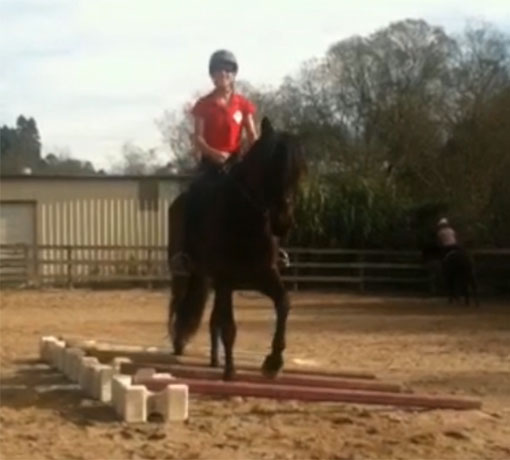 Scroll down to watch a video of this exercise. |
Finally, the mighty thoracic sling of muscles is getting the attention it deserves.
The thoracic sling is generally defined as the ring of muscles that suspends the horse’s chest cavity between his shoulder blades, thereby playing a critical role in lifting his body weight up off the forehand. With our growing awareness of how a horse’s body moves has come the knowledge that this part of his forehand factors hugely in to his ability to carry himself well. Without a well-developed and elastic thoracic sling, any horse will be incapable of lofty gaits or uphill movement.
This area is usually either under-developed or tight from repetitive motion. In both cases, his front legs will take a shorter stride than is optimal, which also restricts the range of motion from his hind legs. His gaits will often become bouncy or jarring to ride because this prime area of shock absorption is not working properly. In order to carry his rider with ease and grace, the horse needs to have equal measures of strength and looseness in his thoracic sling.
You can help accomplish this with an exercise that strikes riders as almost too simple to produce the benefits it does. Where postural muscles are concerned, however, simple and slow-moving exercises always deliver better results. So, do your horse a favor and commit to starting each training session by walking over a line of raised ground poles.
Five poles is a good number, but if you have access to more than that, eight poles are ideal. Also, if you’re able to find a place on your facility to leave the poles set up—perhaps in an un-used paddock area, driveway, lawn—you will find it a lot more feasible to ride them consistently. If you have to set them up each time, you will soon find excuses to skip doing them.
Once you have mounted up, head over to the ground poles and walk back and forth over them at least 20 times. You may choose to use a turn-on-forehand to reverse your line of travel after each time crossing the poles, or you might just ride a small loop. All that matters is that you give yourself enough room on your approach to maintain an energetic and lively walk. Keep your horse on a loose rein if you can. The point of riding the poles is to create a maximum range of motion in his shoulders and mobilize his spinal joints, so you want to ensure his frame is as unrestricted as possible.
Since I ride all different ages and levels of horses each day, I prefer to raise just one side of the poles to a height of eight inches. The other side of each pole rests on the ground. This way, if I am riding an uncoordinated youngster who might trip over the raised poles, I can shift our line of travel to the lower end where he is still benefiting from the exercise but not stubbing his toe and falling on his face. An ideal spacing of raised walking poles for an average sized horse is 2’ to 2.5’. The spacing needs to be such so that the horse can take a normal and comfortable stride length, neither extending his stride nor shortening it to step between each pole.
I always remind riders that they should ride back and forth over the poles enough times to feel something change in their horse’s way of going. Does it suddenly feel like your horse’s back is swinging more underneath you? Does his neck begin to loosen and stretch more forward? Does his walk become more purposeful and engaged? Feel for these changes; learn to recognize them. Remember to keep your eyes up, ride an arrow-straight line, and reap the benefit of simple but effective exercise!
Liked this article? Here are others you’ll love:
How to Ride a Turn on the Forehand
Improve Your Horse’s Fitness with Trot-to-Canter Transitions






Excellent!
great info
What a great idea, and I sure hope I will remember it next spring.
would have liked info also about spacing when one is trotting thru the poles